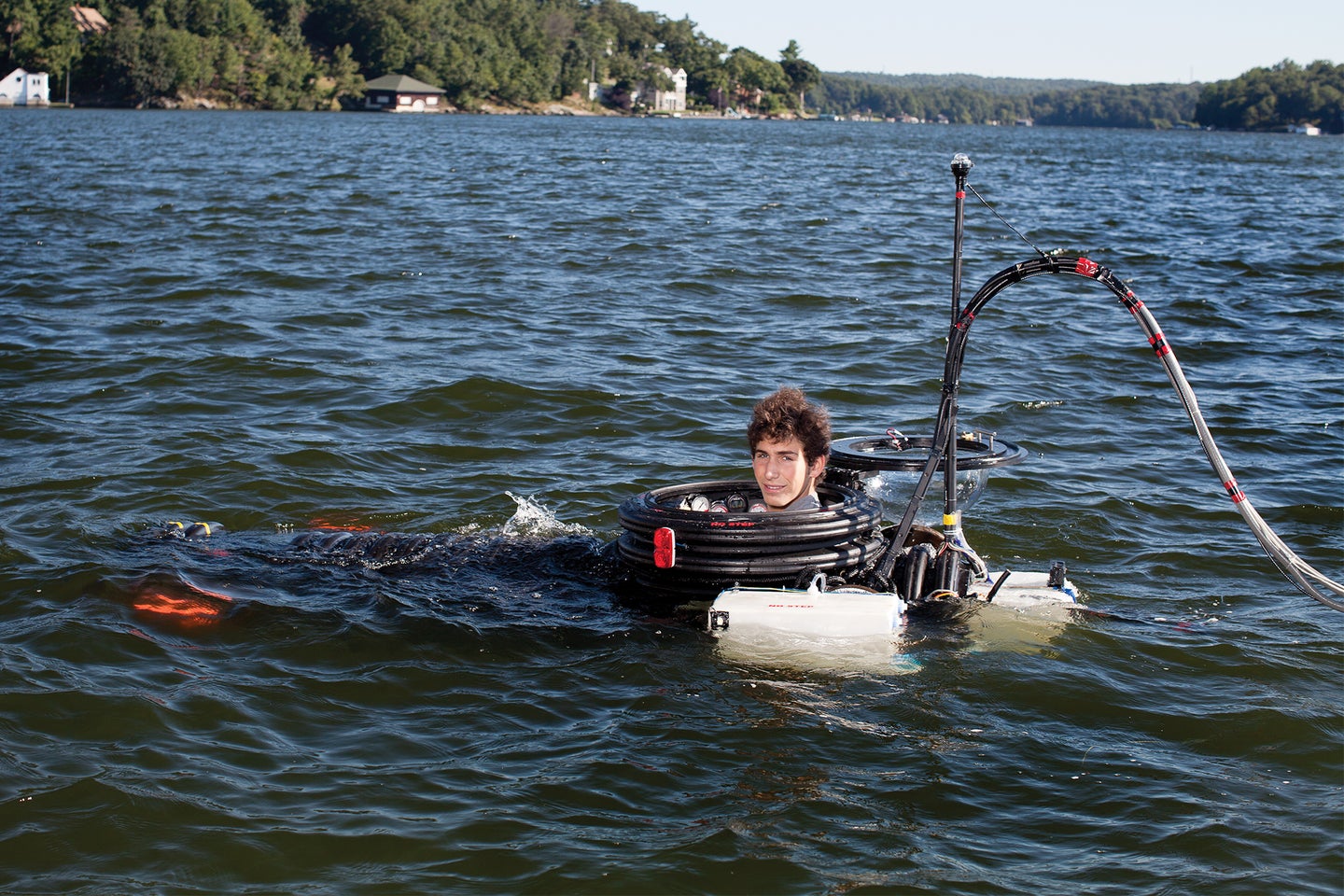A DIY Submarine That Can Dive 30 Feet
It's even got a skylight.

Justin Beckerman was walking to high school with some friends when one of them spied an abandoned soda fountain in a parking lot. “Dude, you should go and get that,” his buddy said. He knew Beckerman was collecting parts to build a one-man submersible, with the hope of piloting around New Jersey’s four-square-mile Lake Hopatcong. After school, Beckerman dismantled the soda fountain, harvested several pieces from the machine, including a compressed-air regulator, and rushed home to get to work.
The 18-year-old’s love of building took off at age two, when his dad started taking him to a junkyard to hunt for old computers, printers, and motors. The junkyard manager got to know Beckerman and his dad and saved his best components for them. Friends, family, and even random strangers helped by dropping off parts at their house. Over the years, Beckerman learned to transform these scraps into miniature hovercrafts, imitation Mars rovers, a wind turbine, and other complex machines. Instead of trying to perfect something the first time, he constructs multiple versions. “I learn from my experiments,” he says.
Nautilus, as Beckerman calls it, isn’t his first manned submarine. Version 1.0 felt too cramped, and he wanted to add room and range—to that end, he convinced his parents to buy an eight-foot-long, two-foot-wide section of a corrugated plastic drainage pipe.
‘I could cut it, glue it, and screw it and not have to worry about welding’
“I could cut it, glue it, and screw it and not have to worry about welding,” he says. Beckerman wanted to sit upright in the sub, with outstretched legs, and peer through a dome. So after sawing the pipe to size, he cut a porthole on top, added a skylight of ¼-inch-thick acrylic, and waterproofed the seams with marine epoxy. Four 10-gallon plastic water containers serve as ballast tanks, which take in or expel water to lower and raise the sub. He connected a 1.5-gallon air compressor to the soda machine’s regulator and used a four-way splitter to feed air to each of the tanks. Using solenoid valves, he can activate the compressor, pump air into the tanks to expel water, and rise from the depths. Meanwhile, a trolling motor attached to the stern propels the sub.
Before plunging Nautilus into the lake for the first time, Beckerman tested its controls in his basement. “I was pushing its limits before I got it into the water,” he says. The compressor became so hot it melted some wires, so he added a fan and switched to more resilient high-gauge wire. Once in the lake, the sub wouldn’t submerge—the ballast tanks didn’t add enough weight. (As a temporary measure, his little brothers stood on top to force it under.) Beckerman upgraded the valves, added dumbbells and sandbags, and, with his parents watching closely, submerged on his own. “Once I went down, all the systems got quiet,” he recalls. “It was really strange.”
After making a few improvements, Beckerman packed a small snack, piloted the sub to a deeper section of the lake, descended seven feet, and remained there for 30 minutes. A radio antenna running up to a float allowed him to communicate with his parents. Everything went well until the very end, when he reported there was a problem. “What is it?” his concerned father asked. Beckerman replied, “I’m out of Oreos.”

How It Works
1. Safety and Communication
A 30-foot-long umbilical of hoses and cables connects the sub to an emergency float. Beckerman can dive no deeper, as the Nautilus can’t pull the float’s buoyant Styrofoam down with it. Computer fans circulate fresh air through the sub via the hoses. The cables, meanwhile, lead to an antenna that allows Beckerman to chat with his parents by radio and wireless video.
2. Depth
Four plastic water containers and an air compressor make up the ballast system, which controls the submarine’s depth. The sub still wasn’t heavy enough to sink, so Beckerman added 13 sandbags and 250 pounds of weights too.
3. Illumination
Five different clusters of super-bright LEDs, including this cluster of four lights on the stern of the sub, help illuminate the lake’s murky waters on deeper dives.
4. Air
A compressor stuffed into the back of the sub pumps the ballast tanks full of air. If the fans that circulate air from the surface fail, Beckerman can also use the compressor as a makeshift snorkel.
5. Controls
Three voltmeter readouts [red numbers] keep tabs on the sub’s electrical systems. Beckerman can also see the lake bed on an old DVD-player screen, which is connected to a tiny video camera on the vessel’s bow.
6. Navigation
A magnetic compass assists with basic navigation, and a sonar-powered fish finder helps the pilot determine how close the vessel is to the bottom.
7. Steering
Two custom-made fins, linked to a control rod repurposed from the steering mechanism of an old JetSki, help the pilot guide the craft up or down.
WARNING: We review all our projects before publishing them, but ultimately your safety is your responsibility. Always wear protective gear, take proper safety precautions, and follow all laws and regulations.
This article originally appeared in the October 2013 issue of Popular Science.